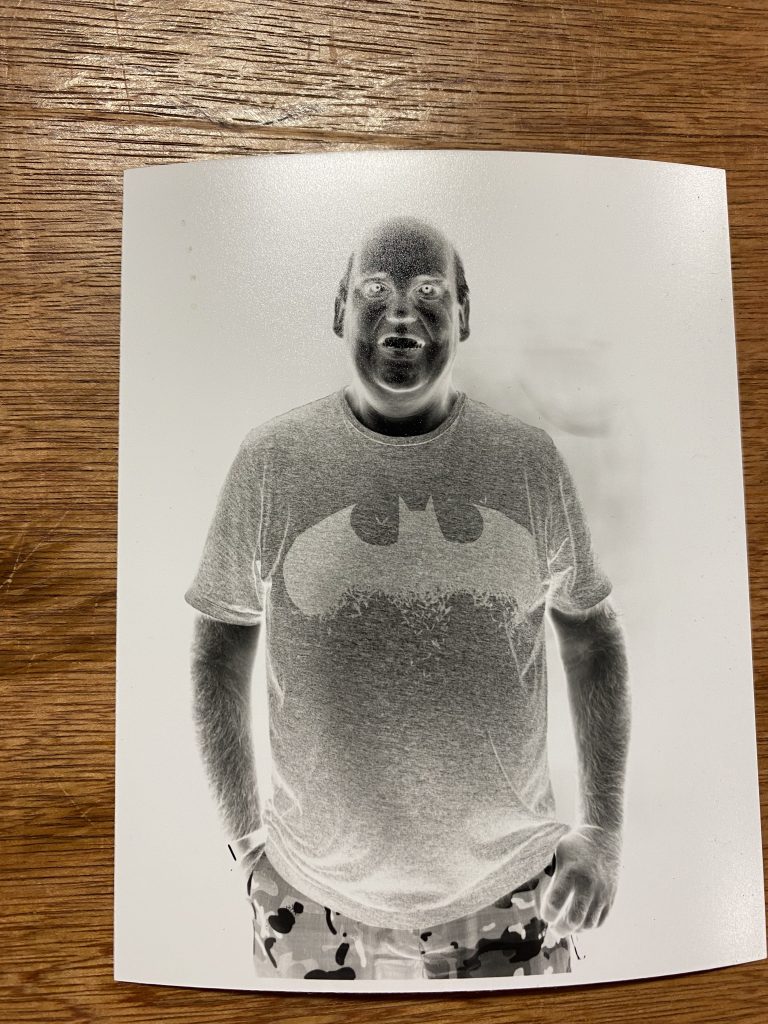Another post on photography, inspired by something I saw in the darkroom at University Of Wolverhampton developing our simple 5×4 Resin Coated paper negatives and contact prints.
Whilst in the darkroom, Dan used an enlarger to expose the RC paper through the negative and I have never seen an enlarger in use before. It was intriguing to see the timer working to allow only the correct amount of light to affect the paper but then I got to thinking more about how this actually worked.
Silver-Halide Hello!
Reading further into it I can see that most common films/papers use a silver-halide composition in the emulsion on the side of the media exposed to the light through the lens, or pinhole etc. The light coming through the aperture affects the silver-halide crystals and then through the developing process the affected crystals are changed to silver by use of the appropriate chemistry. Then other chemistry is used to remove the unused silver-halide and prevent any further changes to the chemicals on the medium.
The image negative seen in our first foray into this process on RC paper, are made up of dark areas where the light affected it most, and lighter areas where less light made it through to the paper. This results in a negative image where a black background becomes white and white light reflecting from my teeth and highlights from my massive forehead are darker.

Doing a contact print and shining light through this negative onto another sheet of RC paper, reverses the image.
Film vs Paper Negatives
After using the RC paper I wondered what the difference was between this and conventional camera film, it appears that the basic difference is that film is usually a plastic medium and this makes it easier for the chemistry to leave behind the developed image and the darker sections of an image can more easily pass light through a partially transparent plastic than it would be through RC paper. As the light can easily travel through the plastic it gives a sharper and crisper image as the thickness of the paper isn’t there to soften and disperse the light.
Enlargers. No not those emails you get….
Once I’d had a brief intro into the chemical properties of the process I looked further into enlargers. We shone the light from the enlarger onto the two pieces of RC paper in contact with each other on the bed of the enlarger. Obviously it’s called an enlarger for the reason that it enlarges images from negatives and I asked Dan in the dark room if you held the negative up in front of the light source and then projected through so that it masked off the parts of the print that didn’t need light exposing it. He said that it’s very much the case, very similar to how an overhead projector (remember those?) works and I should see how it was working.
Enlargers led me on to facebook marketplace to see how much an enlarger would cost on the second hand market and whilst browsing, I’m not buying because we can use the Uni enlargers anytime, I noticed that there were colour enlargers. I then considered how a colour enlarger would differ from a black and white enlarger. Investigating the images on a user’s sale post I could see that there were other controls on the head, that looked like different coloured lights could be shone through the negative.
Thinking about it logically, colour film captures a negative of a colour image that comes into the camera via an aperture. The different colours of the spectrum that make up light must affect the film in different manners, I know from basic physics and some astronomy knowledge that light travels in waves with different colours being different wavelengths so I figured that the chemicals in the film must be affected by this property of light.

Layer Cake
Doing some digging I can see that black and white film is made of a few layers, and colour film is made up of even more layers. It appears that the layers in a colour film are separated into the different chemical makeups that are chemically altered by the appropriate colour. The light reflecting back from a red poppy would affect the red capturing layer more than the green for instance. Between the layers are filters to prevent the light affecting the layer above from affecting the below layers.
Each of the layers in the film are sensitive to a different part of the spectrum and are Yellow, Magenta and Cyan which are sensitive, respectively to Blue, Green and Red light. So when green grass is captured in an image, the light reflects from the grass, into the aperture and changes the chemical properties on the magenta layer before being filtered out so it won’t affect the cyan/red sensitive layer.
The enlarger fires light through the negative onto the bed which has the colour print paper held down to it. The colour paper has three colour sensitive layers also, but they are usually the reverse of the film, with Yellow being on the bottom and cyan on the top. Simplified, if you take a picture of a red ball, the light travels through the negative and allows the red to reach the paper, where it changes the red-sensitive layer’s chemical make up which then appears in the developing process as red on the print.
Wow, this makes my brain hurt, and I’ve only just started!!
Instant Regret
Next, I was in my daughter’s room looking at her wall of Instax prints and my curiosity got the better of me again. How on earth do polaroid/instax colour instant photos work?

The limited knowledge I have about photography and developing films, tells me that there is some quite complex and necessarily accurate chemistry involved. I knew almost nothing of these process before last week’s brief introduction to developing photographs, due to spending twenty years using digital cameras.
Further research led me to a number of videos but the most helpful was Linda Yan’s “How a polaroid camera works” It goes into the layers of the film that are sensitive to different colour light and then also explains how the chemistry is applied to the image.
I’d recommend you watch Linda’s, carefully and thoughtfully explained, video but simply it operates in a similar manner to normal film photography but the chemicals are stored in the larger white border of the photo which are squeezed between rollers when the image is taken and forced up into the sealed multiple layers of colour sensitive materials.
Amazingly the layers and chemicals also have multiple other roles like preventing light from affecting the image in the future and causing the developing chemicals to neutralise preventing further over-developing. It’s an awesomely complex system that was invented almost a century ago and produced commercially from 1948 onwards.
Myths about Instant Photos
The song “Hey Ya!” by Outkast contains lines regarding the process of shaking one’s derriere “like a polaroid picture” which I also found out is unnecessary for the process of developing these instant photos. In actual fact, shaking an instant photo can actually prevent the image from being developed as designed due to the chemicals being concentrated in an area rather than being spread out evenly across the surface.
Another myth I discovered regarding instant photos was that they don’t need drying by waving them in the air. I always believed that the air drying process was responsible partly for the development of the images but the image layers and chemicals are all held within a sealed envelope so there is no part of the image emulsion layers open to the atmosphere.
I will still continue to listen to Outkast on my iPhone though, even though I’ve lost some respect for their photography process knowledge. It’s also called into question how historically accurate the contents of the track “Dracula’s Wedding” might be..
Be First to Comment